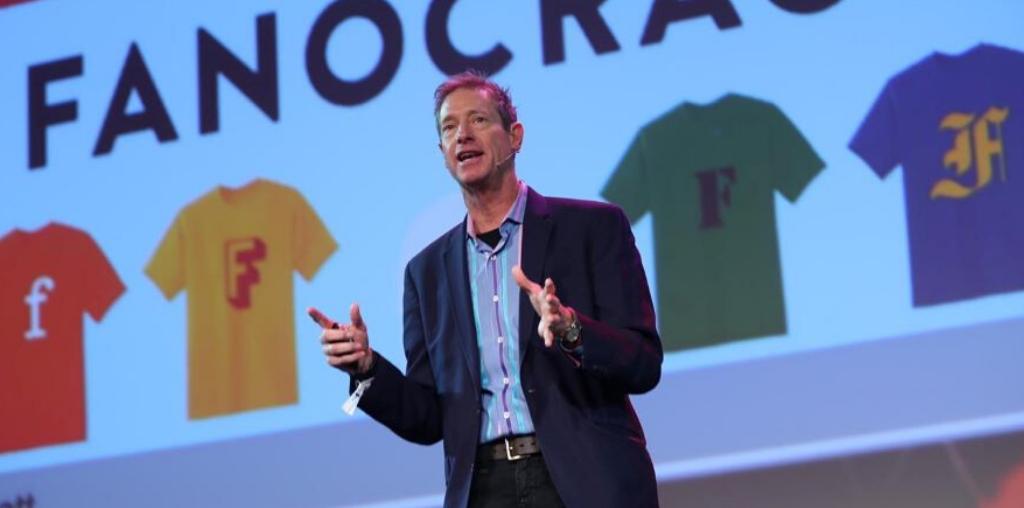B2B marketers need to enter their customers’ virtual personal space to encourage them to become brand ‘fans’, says bestselling author David Meerman Scott.
David Meerman Scott’s The New Rules of Marketing and PR was one of the first books to document the rise of social media and inbound marketing. First released in 2007 and now in its sixth edition and available in 29 languages, the book has helped a generation of marketers find success in our hyperconnected world.
So we must pay attention to Scott when he says sadly, “this whole online marketing thing has gotten a little bit out of control”.
Scott says his intention wasn’t to create a noisy world where everyone clamours for the attention of potential customers, “constantly barraging them with online information”. But that’s what has happened.
“The pendulum has swung too far in the direction of superficial online communication,” he says.
What’s the antidote?
Scott’s latest book, Fanocracy, celebrates a revolution slowly starting to turn the tide away from people ‘shouting’ at their audience to ‘connecting’ with them. He calls it “turning fans into customers and customers into fans”.
Like a democracy or meritocracy, a ‘fanocracy’ is a place where fans rule. Think of it as customer-centricity on steroids.
Do you remember the old Ladder of Customer Loyalty? In essence, the model proposes customers become advocates (David would probably call them “fans”) by climbing a ‘loyalty ladder’. As their brand loyalty increases, they move from suspects to prospects to customers to clients to supporters to advocates.
When customers become fans, Scott says, they naturally want to share this excitement with others and get close to people like them. As a result, they create a sense of contagious excitement or enthusiasm.
He noticed it himself while attending Grateful Dead concerts. His daughter, Reiko, found it through her love of Harry Potter. They saw when brand interest becomes an attraction, perhaps even a compulsion, their need to be ‘close’ to other fans allows them to share this passion with others more successfully
The proximity principle: four levels of ‘closeness’
Scott and Reiko decided to research the concept of ‘closeness’, and how it might apply to marketing. They discovered this sense of kinship among strangers underpins the philosophy of fandom and the desire to connect with others sharing brand love is enhanced by proximity.
“Neuroscientists say the reason for this is the closer we get to someone physically, the more powerful the shared human emotion is,” he says.
Fanocracy explains the principles of proxemics discovered by neuroscientist Edward T. Hall and why it is changing marketing. The principles are particularly relevant for B2B marketers.
It comes down to how humans respond to their nearness to others and can be explained by four levels of proximity. There’s public space – further than six metres – where we don’t really connect with people. Then there’s social space – if we’re within about six metres we can’t help but pay attention to people – it’s hardwired into our human DNA.
“Can you create more opportunities to get close to existing and potential customers? Can you have more opportunities to meet people over lunch?”
The most potent space – which is essential for B2B marketers – is what happens when we come within a couple of metres of someone. This becomes personal space. The fourth level, intimate space, is a bit too close for comfort in a business context.
So, should B2B marketers start getting in their customers’ ‘virtual personal space’? Yes, because that’s when you activate the potential for increased human connection. It’s why personal videos work. It’s also why selfies (love them or hate them) are so powerful.
It comes down to the power of mirror neurons, says Scott. “These are the part of our brain that fires when we see someone doing something as if we’re doing it ourselves,” he says. Video, for instance, activates these mirror neurons. They allow us to create a virtual personal space with someone a state, country or even continent away. They build an emotional connection as if we had met them face to face.
How to build fans: two lessons for B2B marketers
The closer you get to someone, the more powerful the human connection. And, ultimately, the greater the trust built between you and your customers (or ‘fans’), the greater their likelihood to recommend you through word-of-mouth marketing. The more convincing and compelling your stories and case studies, the easier it is to convert marketing into revenue.
But how do you make this happen?
First, as a marketer, you need to get into the virtual personal space of your customers. Scott asks, "Can you have videos that you push out on a YouTube channel, your site and maybe Facebook Live, maybe Instagram video, where you’re talking directly into the camera and relating to people on this virtual, personal level?” These tactics may seem cheesy or unprofessional to senior B2B marketers, but they work. And science confirms it.
Second, don’t underestimate the power of hosting or attending events to get physically close to people. “They are incredibly powerful,” Scott says. “Can you, for example, create more opportunities to get close to existing and potential customers? Can you have a client conference where you bring people together for a day? Can you have more opportunities to meet people over lunch?”
Neuroscience informs us how we can develop fans. Proper human connections keep those fans. What marketers need to take away is this: be human and encourage your whole company to build and maintain those connections.
The B2B Marketing Leaders Forum events in Sydney, Singapore and Melbourne feature insights from the world’s leading B2B marketers. To find out more, go to b2bmarketingleaders.com.au
Further reading: Xero's solution to making B2B technology more human


